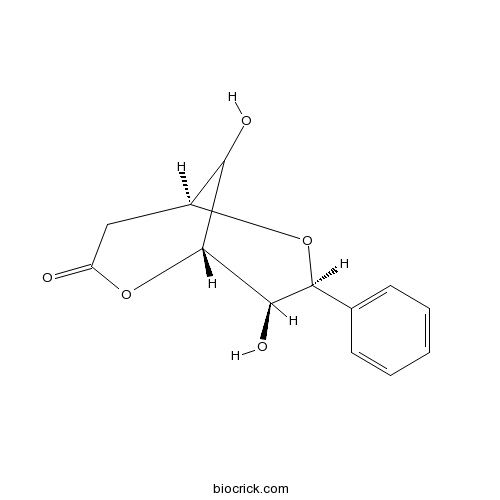GoniopypyroneCAS# 129578-07-0 |

Quality Control & MSDS
3D structure
Package In Stock
Number of papers citing our products

| Cas No. | 129578-07-0 | SDF | Download SDF |
| PubChem ID | 164274 | Appearance | Cryst. |
| Formula | C13H14O5 | M.Wt | 250.3 |
| Type of Compound | Phenols | Storage | Desiccate at -20°C |
| Solubility | Soluble in Chloroform,Dichloromethane,Ethyl Acetate,DMSO,Acetone,etc. | ||
| Chemical Name | (1S,3S,4R,5R)-4,9-dihydroxy-3-phenyl-2,6-dioxabicyclo[3.3.1]nonan-7-one | ||
| SMILES | C1C2C(C(C(C(O2)C3=CC=CC=C3)O)OC1=O)O | ||
| Standard InChIKey | XIHDWURQMYWEBZ-NFNQGEQYSA-N | ||
| Standard InChI | InChI=1S/C13H14O5/c14-9-6-8-10(15)13(18-9)11(16)12(17-8)7-4-2-1-3-5-7/h1-5,8,10-13,15-16H,6H2/t8-,10?,11+,12-,13+/m0/s1 | ||
| General tips | For obtaining a higher solubility , please warm the tube at 37 ℃ and shake it in the ultrasonic bath for a while.Stock solution can be stored below -20℃ for several months. We recommend that you prepare and use the solution on the same day. However, if the test schedule requires, the stock solutions can be prepared in advance, and the stock solution must be sealed and stored below -20℃. In general, the stock solution can be kept for several months. Before use, we recommend that you leave the vial at room temperature for at least an hour before opening it. |
||
| About Packaging | 1. The packaging of the product may be reversed during transportation, cause the high purity compounds to adhere to the neck or cap of the vial.Take the vail out of its packaging and shake gently until the compounds fall to the bottom of the vial. 2. For liquid products, please centrifuge at 500xg to gather the liquid to the bottom of the vial. 3. Try to avoid loss or contamination during the experiment. |
||
| Shipping Condition | Packaging according to customer requirements(5mg, 10mg, 20mg and more). Ship via FedEx, DHL, UPS, EMS or other couriers with RT, or blue ice upon request. | ||
| Description | 1. (+)-Goniopypyrone suppresses the growth of cultured Ehrlich ascites tumor cells as well as PU5-1.8 cells. |

Goniopypyrone Dilution Calculator

Goniopypyrone Molarity Calculator
| 1 mg | 5 mg | 10 mg | 20 mg | 25 mg | |
| 1 mM | 3.9952 mL | 19.976 mL | 39.9521 mL | 79.9041 mL | 99.8801 mL |
| 5 mM | 0.799 mL | 3.9952 mL | 7.9904 mL | 15.9808 mL | 19.976 mL |
| 10 mM | 0.3995 mL | 1.9976 mL | 3.9952 mL | 7.9904 mL | 9.988 mL |
| 50 mM | 0.0799 mL | 0.3995 mL | 0.799 mL | 1.5981 mL | 1.9976 mL |
| 100 mM | 0.04 mL | 0.1998 mL | 0.3995 mL | 0.799 mL | 0.9988 mL |
| * Note: If you are in the process of experiment, it's necessary to make the dilution ratios of the samples. The dilution data above is only for reference. Normally, it's can get a better solubility within lower of Concentrations. | |||||

Calcutta University

University of Minnesota

University of Maryland School of Medicine

University of Illinois at Chicago

The Ohio State University

University of Zurich

Harvard University

Colorado State University

Auburn University

Yale University

Worcester Polytechnic Institute

Washington State University

Stanford University

University of Leipzig

Universidade da Beira Interior

The Institute of Cancer Research

Heidelberg University

University of Amsterdam

University of Auckland

TsingHua University

The University of Michigan

Miami University

DRURY University

Jilin University

Fudan University

Wuhan University

Sun Yat-sen University

Universite de Paris

Deemed University

Auckland University

The University of Tokyo

Korea University
- Tolfenpyrad
Catalog No.:BCC8069
CAS No.:129558-76-5
- Verteporfin
Catalog No.:BCC3690
CAS No.:129497-78-5
- 3,4-Diacetoxycinnamamide
Catalog No.:BCN6157
CAS No.:129488-34-2
- Fmoc-Asp-OtBu
Catalog No.:BCC3088
CAS No.:129460-09-9
- Fulvestrant
Catalog No.:BCC1081
CAS No.:129453-61-8
- Boc-Cysteinol(pMeBzl)
Catalog No.:BCC3044
CAS No.:129397-85-9
- Fmoc-Phenylalaninol
Catalog No.:BCC2717
CAS No.:129397-83-7
- Euphorbia factor L9
Catalog No.:BCN3786
CAS No.:129393-28-8
- Physcion 8-O-rutinoside
Catalog No.:BCN7324
CAS No.:129393-21-1
- 11-Chloro-2,3,3a,12b-tetrahydro-2-methyl-1H-dibenz[2,3:6,7]oxepino[4,5-c]pyrrol-1-one
Catalog No.:BCC8430
CAS No.:129385-59-7
- O-Geranylconiferyl alcohol
Catalog No.:BCN4747
CAS No.:129350-09-0
- Alendronate sodium
Catalog No.:BCC3719
CAS No.:129318-43-0
- Satraplatin
Catalog No.:BCC5356
CAS No.:129580-63-8
- Nevirapine
Catalog No.:BCC3820
CAS No.:129618-40-2
- GR 82334
Catalog No.:BCC5802
CAS No.:129623-01-4
- 3-Hydroxybisabola-1,10-dien-9-one
Catalog No.:BCN7325
CAS No.:129673-86-5
- 3,4-Dihydroxybisabola-1,10-diene
Catalog No.:BCN7326
CAS No.:129673-87-6
- ZD 7114 hydrochloride
Catalog No.:BCC6852
CAS No.:129689-28-7
- Dofequidar
Catalog No.:BCC4176
CAS No.:129716-58-1
- Aripiprazole
Catalog No.:BCC5034
CAS No.:129722-12-9
- 2',4'-Dihydroxy-3',6'-dimethoxychalcone
Catalog No.:BCN6158
CAS No.:129724-43-2
- 3-Hydroxylanost-9(11)-24-dien-26-oic acid
Catalog No.:BCN1586
CAS No.:129724-83-0
- Anemoside A3
Catalog No.:BCN2328
CAS No.:129724-84-1
- Anemoside B4
Catalog No.:BCN1276
CAS No.:129741-57-7
Antitumor effect of chemically synthesized (+)-goniopypyrone.[Pubmed:8458246]
Chemotherapy. 1993 Mar-Apr;39(2):132-4.
Chemically synthesized (+)-Goniopypyrone was found to suppress the growth of cultured Ehrlich ascites tumor cells as well as PU5-1.8 cells. The ED50 values were found to be 35 and 30 micrograms/ml for the two cell lines used. An LD50 of 193 micrograms/ml was observed in the brine shrimp bioassay.
Cytotoxic styryl-lactones from the leaves and twigs of Polyalthia crassa.[Pubmed:17190450]
J Nat Prod. 2006 Dec;69(12):1728-33.
Four new styryl-lactones, crassalactones A-D (1-4), were isolated from a cytotoxic ethyl acetate-soluble extract of the leaves and twigs of Polyalthia crassa, together with seven known compounds, (+)-3-acetylaltholactone, (+)-altholactone, aristolactam AII, cinnamic acid, (+)-goniofufurone, (+)-Goniopypyrone, and (+)-howiinol A. Their structures were determined on the basis of spectroscopic methods. The absolute configuration of 1-3 was established by chemical conversions. Single-crystal X-ray analysis and the Mosher ester method were used to confirm the absolute stereochemistry of 4. Cytotoxic evaluation against several mammalian cancer cell lines was performed on all new isolates, aristolactam AII, and the modified (+)-tricinnamate derivative 11 obtained from 1.


